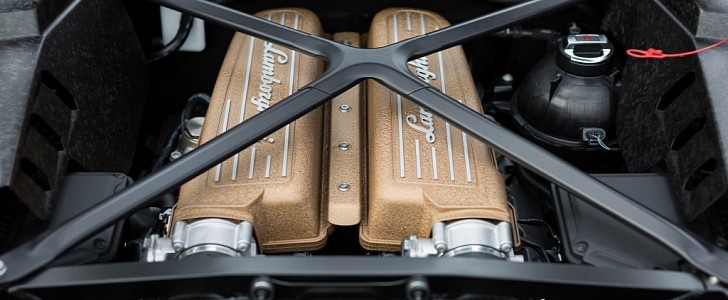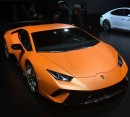Envisioned by Italdesign as the heir apparent of the V8-engined Jalpa, the Cala concept sported a 4.0-liter V10 capable of 395 horsepower. After the VW Group took control of Lamborghini, the automaker from Sant’Agata Bolognese finally launched an entry-level supercar in 2003.
Originally equipped with an even firing 5.0-liter V10, the Gallardo leveled up to an odd firing 5.2-liter V10 in 2008. The Huracan followed suit in 2014 with an evolution of the 5.2-liter V10, an engine shared with the Audi R8.
The LP 610-4, which stands for a longitudinally-mounted powerplant with 610 metric ponies and all-wheel drive, was only the start of the Huracan dynasty. The Raging Bull subsequently launched a less powerful rear-driven model, followed by the Performante, which lapped the Nurburgring Nordschleife in six minutes and 52 seconds. Facelifted in 2019, the mid-engined thoroughbred presently belts out up to 640 ps (631 horsepower).
As you're well aware, that's not enough by modern standards. McLaren and Ferrari have both launched twin-turbo V6 plug-in hybrids with ridiculous power and torque. The supercar segment has been forced by lawmakers to adopt forced induction and hybrid assistance; otherwise, McLaren and Ferrari wouldn't have pleased the European Commission and Environmental Protection Agency. Given these circumstances, and the Lamborghini Huracan's increasing age, have a wild guess of what's going to happen next.
October 2017 is when Stefano Domenicali, the former head honcho of Lamborghini, declared that “hybridization is the answer.” Fast forward to January 2022, and that’s when current big kahuna Stephan Winkelmann said that “we are not yet disclosing what type of engine it’s going to be” in the Huracan’s replacement. He added that “it’s a completely new engine; nothing in common with the Urus or Aventador.” Pretty intriguing, right?
CAR Magazine understands that a high-revving V8, unrelated to the 4.0-liter unit of the Urus, will be used in the yet-to-be-named successor of the Huracan. This engine is reportedly capable of redlining to 10,000 revolutions per minute and is compatible with synthetic fuel. 850 hybrid-assisted horsepower are rumored, which is impressive by today's standards.
Auto Express are much obliged to confirm plug-in hybridization. Chief technical officer Rouven Mohr told the cited publication that “it will be plug-in hybrid. The engine will be bespoke for Lamborghini. On the final details we can’t yet communicate this, but I would say more than six and less than 12 cylinders.” Obviously enough, Mohr is referring to the V8 or the existing V10.
The V10 isn’t bespoke to Lamborghini for the time being, but it will be soon enough because Audi Sport is following the full-electric strategy of the German automaker. With the R8 going electric, the V10 can be considered a Lamborghini-exclusive powerplant. The question is, will it be this amazing-sounding V10 or the high-revving V8 speculated by CAR Magazine?
Whatever the future holds, the Huracan will continue production into 2023. The Sterrato has been recently spied in Sant’Agata Bolognese with production-ready bits and pieces, and the grand reveal is expected next month. The Huracan’s successor is believed to enter production in 2024.
The LP 610-4, which stands for a longitudinally-mounted powerplant with 610 metric ponies and all-wheel drive, was only the start of the Huracan dynasty. The Raging Bull subsequently launched a less powerful rear-driven model, followed by the Performante, which lapped the Nurburgring Nordschleife in six minutes and 52 seconds. Facelifted in 2019, the mid-engined thoroughbred presently belts out up to 640 ps (631 horsepower).
As you're well aware, that's not enough by modern standards. McLaren and Ferrari have both launched twin-turbo V6 plug-in hybrids with ridiculous power and torque. The supercar segment has been forced by lawmakers to adopt forced induction and hybrid assistance; otherwise, McLaren and Ferrari wouldn't have pleased the European Commission and Environmental Protection Agency. Given these circumstances, and the Lamborghini Huracan's increasing age, have a wild guess of what's going to happen next.
October 2017 is when Stefano Domenicali, the former head honcho of Lamborghini, declared that “hybridization is the answer.” Fast forward to January 2022, and that’s when current big kahuna Stephan Winkelmann said that “we are not yet disclosing what type of engine it’s going to be” in the Huracan’s replacement. He added that “it’s a completely new engine; nothing in common with the Urus or Aventador.” Pretty intriguing, right?
CAR Magazine understands that a high-revving V8, unrelated to the 4.0-liter unit of the Urus, will be used in the yet-to-be-named successor of the Huracan. This engine is reportedly capable of redlining to 10,000 revolutions per minute and is compatible with synthetic fuel. 850 hybrid-assisted horsepower are rumored, which is impressive by today's standards.
Auto Express are much obliged to confirm plug-in hybridization. Chief technical officer Rouven Mohr told the cited publication that “it will be plug-in hybrid. The engine will be bespoke for Lamborghini. On the final details we can’t yet communicate this, but I would say more than six and less than 12 cylinders.” Obviously enough, Mohr is referring to the V8 or the existing V10.
The V10 isn’t bespoke to Lamborghini for the time being, but it will be soon enough because Audi Sport is following the full-electric strategy of the German automaker. With the R8 going electric, the V10 can be considered a Lamborghini-exclusive powerplant. The question is, will it be this amazing-sounding V10 or the high-revving V8 speculated by CAR Magazine?
Whatever the future holds, the Huracan will continue production into 2023. The Sterrato has been recently spied in Sant’Agata Bolognese with production-ready bits and pieces, and the grand reveal is expected next month. The Huracan’s successor is believed to enter production in 2024.
































